Page 33 of 364
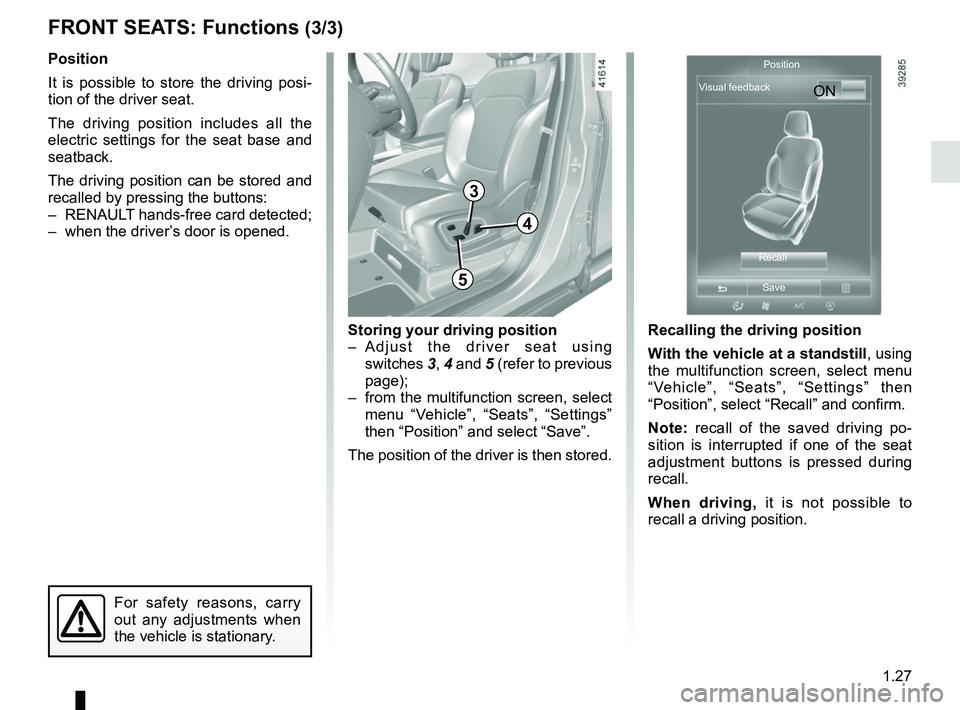
1.27
FRONT SEATS: Functions (3/3)
Position
It is possible to store the driving posi-
tion of the driver seat.
The driving position includes all the
electric settings for the seat base and
seatback.
The driving position can be stored and
recalled by pressing the buttons:
– RENAULT hands-free card detected;
– when the driver’s door is opened.
3
3
Recalling the driving position
With the vehicle at a standstill, using
the multifunction screen, select menu
“Vehicle”, “Seats”, “Settings” then
“Position”, select “Recall” and confirm.
Note: recall of the saved driving po-
sition is interrupted if one of the seat
adjustment buttons is pressed during
recall.
When driving, it is not possible to
recall a driving position.
4
5
For safety reasons, carry
out any adjustments when
the vehicle is stationary.
Storing your driving position
– Adjust the driver seat using switches 3, 4 and 5 (refer to previous
page);
– from the multifunction screen, select menu “Vehicle”, “Seats”, “Settings”
then “Position” and select “Save”.
The position of the driver is then stored. ON
Position
Visual feedback
RecallSave
Page 36 of 364
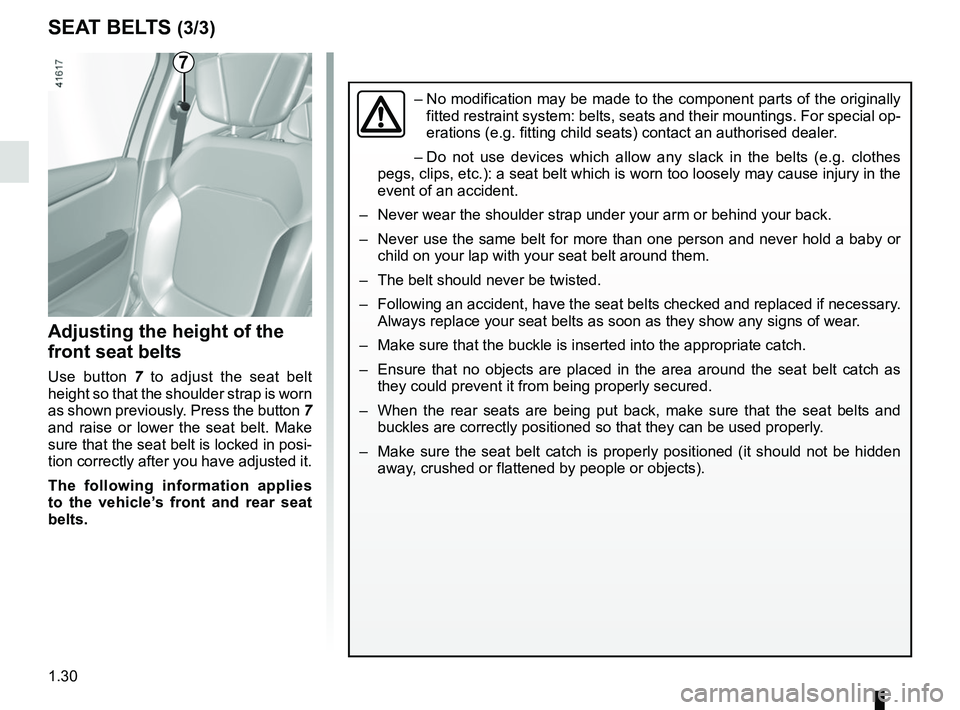
1.30
SEAT BELTS (3/3)
Adjusting the height of the
front seat belts
Use button 7 to adjust the seat belt
height so that the shoulder strap is worn
as shown previously. Press the button 7
and raise or lower the seat belt. Make
sure that the seat belt is locked in posi-
tion correctly after you have adjusted it.
The following information applies
to the vehicle’s front and rear seat
belts.
7
– No modification may be made to the component parts of the originally
fitted restraint system: belts, seats and their mountings. For special o\
p-
erations (e.g. fitting child seats) contact an authorised dealer.
– Do not use devices which allow any slack in the belts (e.g. clothes
pegs, clips, etc.): a seat belt which is worn too loosely may cause inj\
ury in the
event of an accident.
– Never wear the shoulder strap under your arm or behind your back.
– Never use the same belt for more than one person and never hold a baby o\
r child on your lap with your seat belt around them.
– The belt should never be twisted.
– Following an accident, have the seat belts checked and replaced if neces\
sary. Always replace your seat belts as soon as they show any signs of wear.
– Make sure that the buckle is inserted into the appropriate catch.
– Ensure that no objects are placed in the area around the seat belt catch\
as they could prevent it from being properly secured.
– When the rear seats are being put back, make sure that the seat belts an\
d buckles are correctly positioned so that they can be used properly.
– Make sure the seat belt catch is properly positioned (it should not be \
hidden away, crushed or flattened by people or objects).
Page 37 of 364
1.31
Second row centre rear seat
Unwind belt 5 slowly from its housing 4.
Click buckle 9 into black catch 8.
Snap the last sliding buckle 6 into the
red catch 7.
To store away the seat belt, guide it into
housing 4 and store the two buckles
into their respective housings A and B
or, depending on the vehicle, hook
buckle 9 on magnet C.
Second row rear side seats
Slowly unwind belt 1.
Click the sliding buckle 2 into the corre-
sponding red catch 3.
Check that the rear seat
belts are positioned and op-
erating correctly each time
the rear seats are moved.
Rear seat functions
Refer to the information on “Rear
seat functions” in Section 3.
REAR SEAT BELTS
1
Third row rear seats (7-seater
versions)
Slowly unwind the strap 10.
Click the buckle 11 into the correspond-
ing black catch 12.
10
11
12
2
3
9
8
6
7
5
AB
4
C
Page 38 of 364
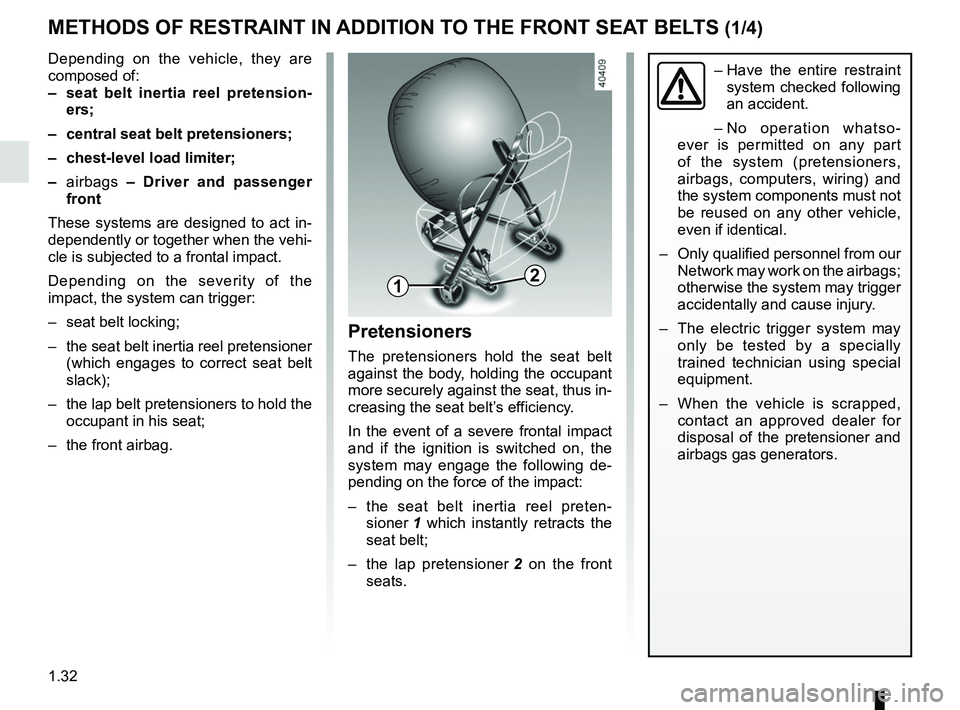
1.32
METHODS OF RESTRAINT IN ADDITION TO THE FRONT SEAT BELTS (1/4)
Depending on the vehicle, they are
composed of:
– seat belt inertia reel pretension-ers;
– central seat belt pretensioners;
– chest-level load limiter;
– airbags – Driver and passenger
front
These systems are designed to act in-
dependently or together when the vehi-
cle is subjected to a frontal impact.
Depending on the severity of the
impact, the system can trigger:
– seat belt locking;
– the seat belt inertia reel pretensioner (which engages to correct seat belt
slack);
– the lap belt pretensioners to hold the occupant in his seat;
– the front airbag.
Pretensioners
The pretensioners hold the seat belt
against the body, holding the occupant
more securely against the seat, thus in-
creasing the seat belt’s efficiency.
In the event of a severe frontal impact
and if the ignition is switched on, the
system may engage the following de-
pending on the force of the impact:
– the seat belt inertia reel preten- sioner 1 which instantly retracts the
seat belt;
– the lap pretensioner 2 on the front
seats.
– Have the entire restraint
system checked following
an accident.
– No operation whatso-
ever is permitted on any part
of the system (pretensioners,
airbags, computers, wiring) and
the system components must not
be reused on any other vehicle,
even if identical.
– Only qualified personnel from our Network may work on the airbags;
otherwise the system may trigger
accidentally and cause injury.
– The electric trigger system may only be tested by a specially
trained technician using special
equipment.
– When the vehicle is scrapped, contact an approved dealer for
disposal of the pretensioner and
airbags gas generators.
12
Page 42 of 364
1.36
METHODS OF RESTRAINT IN ADDITION TO THE REAR SEAT BELTS
Force limiter
It is fitted to the rear side seats in the
second row.
Above a certain severity of impact, this
mechanism is used to limit the force of
the belt against the body so that it is at
an acceptable level.
– Have the entire restraint
system checked following
an accident.
– No operation whatsoever
is permitted on any part of the
system (airbags, electronic units,
wiring) and the system compo-
nents must not be reused on any
other vehicle, even if identical.
– Only qualified personnel from our Network may work on the airbags;
otherwise the system may trigger
accidentally and cause injury.
Page 43 of 364
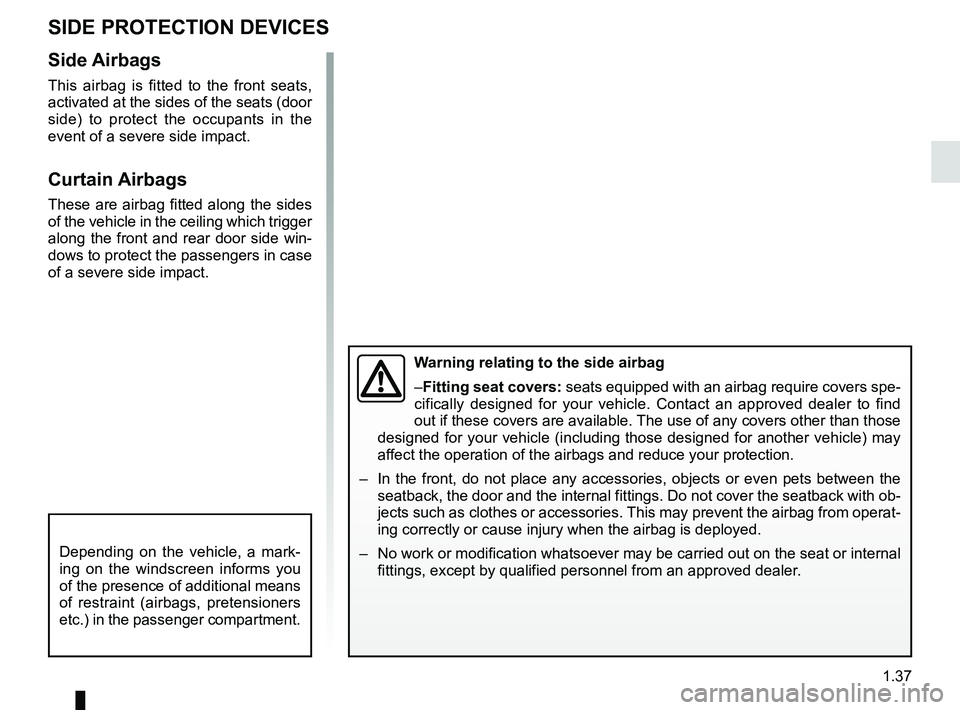
1.37
SIDE PROTECTION DEVICES
Warning relating to the side airbag
–Fitting seat covers: seats equipped with an airbag require covers spe-
cifically designed for your vehicle. Contact an approved dealer to find
out if these covers are available. The use of any covers other than those
designed for your vehicle (including those designed for another vehicle\
) may
affect the operation of the airbags and reduce your protection.
– In the front, do not place any accessories, objects or even pets between\
the seatback, the door and the internal fittings. Do not cover the seatback \
with ob-
jects such as clothes or accessories. This may prevent the airbag from operat-
ing correctly or cause injury when the airbag is deployed.
– No work or modification whatsoever may be carried out on the seat or int\
ernal fittings, except by qualified personnel from an approved dealer.
Side Airbags
This airbag is fitted to the front seats,
activated at the sides of the seats (door
side) to protect the occupants in the
event of a severe side impact.
Curtain Airbags
These are airbag fitted along the sides
of the vehicle in the ceiling which trigger
along the front and rear door side win-
dows to protect the passengers in case
of a severe side impact.
Depending on the vehicle, a mark-
ing on the windscreen informs you
of the presence of additional means
of restraint (airbags, pretensioners
etc.) in the passenger compartment.
Page 46 of 364
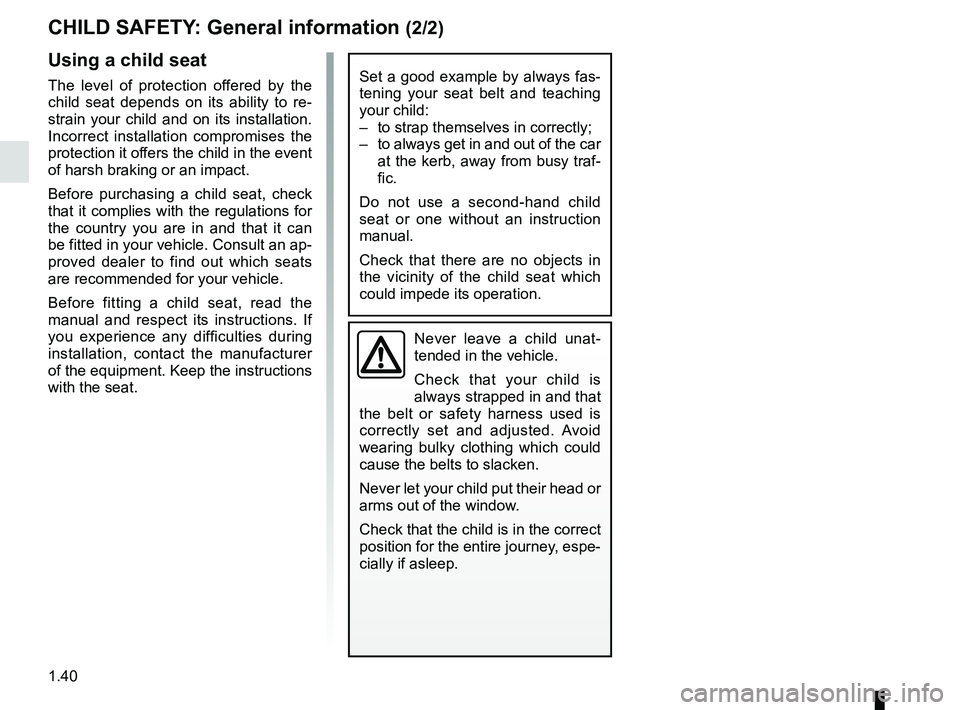
1.40
CHILD SAFETY: General information (2/2)
Using a child seat
The level of protection offered by the
child seat depends on its ability to re-
strain your child and on its installation.
Incorrect installation compromises the
protection it offers the child in the event
of harsh braking or an impact.
Before purchasing a child seat, check
that it complies with the regulations for
the country you are in and that it can
be fitted in your vehicle. Consult an ap-
proved dealer to find out which seats
are recommended for your vehicle.
Before fitting a child seat, read the
manual and respect its instructions. If
you experience any difficulties during
installation, contact the manufacturer
of the equipment. Keep the instructions
with the seat.Set a good example by always fas-
tening your seat belt and teaching
your child:
– to strap themselves in correctly;
– to always get in and out of the car at the kerb, away from busy traf-
fic.
Do not use a second-hand child
seat or one without an instruction
manual.
Check that there are no objects in
the vicinity of the child seat which
could impede its operation.
Never leave a child unat-
tended in the vehicle.
Check that your child is
always strapped in and that
the belt or safety harness used is
correctly set and adjusted. Avoid
wearing bulky clothing which could
cause the belts to slacken.
Never let your child put their head or
arms out of the window.
Check that the child is in the correct
position for the entire journey, espe-
cially if asleep.
Page 47 of 364
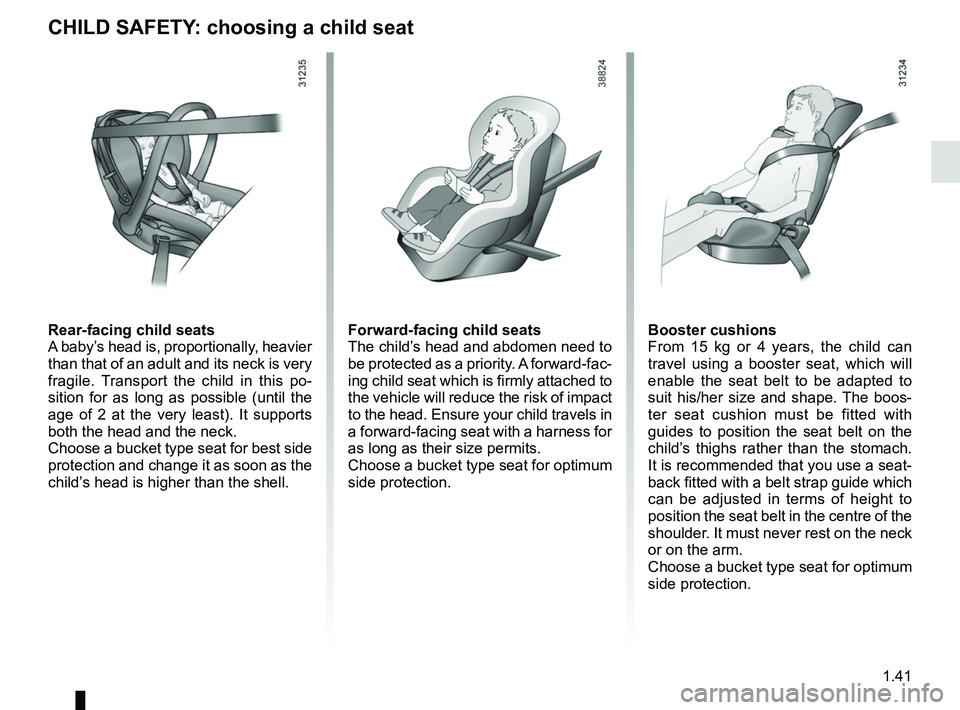
1.41
CHILD SAFETY: choosing a child seat
Rear-facing child seats
A baby’s head is, proportionally, heavier
than that of an adult and its neck is very
fragile. Transport the child in this po-
sition for as long as possible (until the
age of 2 at the very least). It supports
both the head and the neck.
Choose a bucket type seat for best side
protection and change it as soon as the
child’s head is higher than the shell.Forward-facing child seats
The child’s head and abdomen need to
be protected as a priority. A forward-fac-
ing child seat which is firmly attached to
the vehicle will reduce the risk of impact
to the head. Ensure your child travels in
a forward-facing seat with a harness for
as long as their size permits.
Choose a bucket type seat for optimum
side protection.Booster cushions
From 15 kg or 4 years, the child can
travel using a booster seat, which will
enable the seat belt to be adapted to
suit his/her size and shape. The boos-
ter seat cushion must be fitted with
guides to position the seat belt on the
child’s thighs rather than the stomach.
It is recommended that you use a seat-
back fitted with a belt strap guide which
can be adjusted in terms of height to
position the seat belt in the centre of the
shoulder. It must never rest on the neck
or on the arm.
Choose a bucket type seat for optimum
side protection.